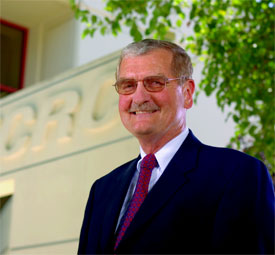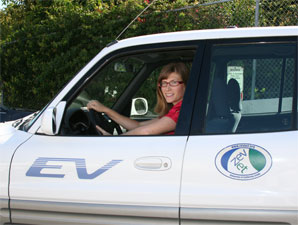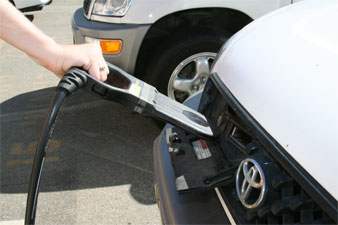IT-Based Infrastructures Power Smart Solutions
By Anna Lynn Spitzer
 |
|
Samuelsen believes information technology
will become "the lifeblood" of future systems.
|
|
Irvine, Calif., Oct. 29, 2007 --
ACT ONE, SCENE ONE: Cars idle bumper-to-bumper on a Southern California freeway, stretching as far as the eye can see. Tailpipes emit noxious fumes while drivers do their own slow burn.
ACT ONE, SCENE TWO: Relaxed commuter disembarks from train at station, walks to front row of parking lot and swipes “smart card” against reader on windshield of Toyota RAV4 electric vehicle. Car unlocks automatically and engine activates. Commuter unplugs car and drives to nearby workplace.
It’s not a pipe dream anymore. The fleet of electric vehicles known as ZEV•NET (Zero Emission Vehicle•Network Enabled Transport) resides at the Irvine Transportation Center. ZEV•NET is one of several real-world solutions born at UC Irvine that integrates information technology in the quest for a cleaner, greener world.
From transportation to power generation to resource monitoring and modeling, IT-based infrastructures will play a vital role in improving our planet’s environment.
Shared Use, Energy Efficiency
A collaboration among the California Air Resources Board, Toyota, and two UCI Calit2-affiliated research centers – the Advanced Power and Energy Program (APEP) and the Institute for Transportation Studies – led to the creation of ZEV•NET in 2002.
The battery-powered RAV4s provide zero-emission transportation. The only shared-use station car program in Southern California, the ZEV•NET fleet is comprised of 16 Toyotas that are contracted to four local companies and a UCI department. Plans are underway to more than double the program’s size next year to 40 cars, and 16 additional companies have expressed interest in participating.
ZEV•NET is user-friendly. Employees commute by train to the Irvine station, drive the vehicles to their companies and share them during the day with co-workers who use them for local business. At day’s end, commuters drive back to the train station, where, for now, they recharge the cars using power from the electric grid. Renovation of the station’s parking structure is currently underway, and when completed, will include a photovoltaic canopy that converts sunlight into electricity for vehicle charging. An onsite fuel cell will provide electricity during non-daylight hours.
Convenient, easy to use and good for the environment. And without IT - impossible.
|
|
|
|
ZEV•NET cars are recharged with paddles that may someday transmit two-way communication along with electricity.
|
|
Users reserve the cars with a Web-based program that triggers a wireless signal, letting a specific car “know” it has been reserved. Drivers access assigned cars with their “smart cards” and when the vehicles are returned, the system logs them in, rendering them available for the next user.
No human intervention is required.
Cars also are equipped with GPS. Usage information is conveyed wirelessly back to UCI, where researchers track the program’s effectiveness.
Modeling the Future
APEP is also working with Toyota to evaluate a prototype plug-in gas/electric hybrid vehicle. The project is part of a $3 million research effort funded by the state to determine how air quality and electricity demand will be affected if the vehicles are widely used.
Researchers will create computer models that simulate the environment at mid-21st century. “We will look down the road and simulate a California urban air basin to assess the impact on air quality as the population of plug-in hybrids increases,” says Scott Samuelsen, director of APEP and its flagship, the National Fuel Cell Research Center (NFCRC). “Everyone assumes air quality will improve, but that needs to be established quantitatively.”
Samuelsen foresees a day when monitoring agencies and utility companies will utilize similar computer models not only to predict problems, but also to trigger responsive action.
“If everyone driving electric cars plugs into the grid to recharge after work, it could be disastrous,” he says.
A “smart plug” built into the vehicles will transmit two-way information along with electricity. Utility companies will have the ability to monitor at what time and how often consumers plug in their vehicles and can institute conservation tactics.
A graduated pricing structure, for example.
“In the future, when you plug in, a chip will identify you to the grid,” predicts Samuelsen. “You might get a message saying, ‘you can charge your car now but it is going to cost you more because it’s peak hours. If you want to pay less, leave it plugged in and we’ll recharge it when there is less demand on the grid, and it will still be ready by the time you need it.’”
Depending on grid conditions or air quality, agencies could even curtail access to electricity or disable gasoline engines if necessary – all from their computer keyboards.
And in the direst conditions, when demand outpaces supply, an IT-enabled system will siphon off energy from vehicles plugged into the grid and direct it to more crucial needs.
That could allow utilities to shave peak power requirements and avoid building new generation plants, and transmission and distribution lines.
“Utilities are intrigued with this concept because not only can they potentially use that battery storage (in the hybrid cars) during peak power demand, but it would help them level out daily grid demand,” says Samuelsen. “It’s a win-win situation and it will all be IT-driven.”
Distributing Power Generation
The California power grid routes electricity from power plants to substations, providing access for more than 30 million consumers. Approximately 80 percent of that electricity is generated by burning fossil fuels, a process that emits carbon dioxide and other greenhouse gases.
In fact, California is the world’s 12th largest source of carbon dioxide, the heat-trapping gas that most scientists believe is a source of global warming. In an attempt to reduce emissions, Gov. Arnold Schwarzenegger signed AB 32 in September 2006. The bill requires a 25 percent reduction – to 1990 levels – in carbon dioxide pollution in the state by 2020. By 2050, emissions must be reduced another 80 percent.
One approach to meeting these requirements is a concept known as distributed generation, in which electricity is produced at the site of its use. Power is generated by means of small-scale technologies, including fuel cells, microturbines and photovoltaic cells. These technologies utilize renewable energy sources as well as conventional fuels, like natural gas.
The systems capture “waste” heat from the fuel cell or combustion-based devices and use it in heating or cooling applications. This increases overall efficiency, displaces the use of additional fuel or electricity for those needs, and ultimately reduces the amount of greenhouse gases and other pollutants.
UCI’s NFCRC is the poster child for distributed generation. A 5-kilowatt fuel cell sits behind the building, supplying enough electricity to meet the peak demands of an average home. Photovoltaic cells, which convert sunlight to energy, are placed on the roof, enhancing reliability of the building. “If the grid does down, we can rely on our fuel cell to produce electricity,” Samuelsen says.
Developing Virtual Utilities
Information technology is crucial to these systems. Generators can be monitored and operated over the Internet, creating a virtual utility. “The word ‘virtual’ is key; IT is making it possible for someone sitting in an office to monitor and control these distributed resources,” Samuelsen says. “If the grid goes down, a person sitting in a different city can switch the power entirely to distributed generators.”
In Orange County, only a few businesses have distributed generation systems, but the trend is “growing like wildfire,” he says.
Across the state, the Franchise Tax Board, Pasadena City College, Santa Barbara County Jail, L.A. Department of Water and Power, and U.S. Postal Service stations, among others, utilize the systems.
A small number of homes – perhaps 1 percent – have photovoltaic panels on their roofs to produce electricity. To increase homeowner participation, Samuelsen’s team is working to develop a better residential system and hopes to test a combined photovoltaic/fuel cell power generator within the next few years.
Information is Power
To educate companies about the benefits of distributed generation and its environmental impact, APEP has teamed up with the California Energy Commission (CEC) to monitor electricity consumption around the state.
Sophisticated equipment collects energy-consumption data up to several times a minute from six sectors – hotels, hospitals and other health-care facilities, jails and prisons, colleges and universities, commercial office buildings and food service businesses, including grocery stores and warehouses. The data, which includes total electric power, and power demands for air conditioning, refrigeration and heating, will be collected for 12 consecutive months and streamed back to UCI, enabling researchers to get a complete, year-long overview of energy usage in each sector.
When the project ends in February 2009, APEP will compile the data and deliver a detailed database to the CEC. The resulting broad-based analysis will indicate the feasibility of installing on-site distributed generation systems in each business sector.
“This is something that has never been done before,” says Rich Hack, APEP senior research engineer. “There have been spot checks done or a detailed analysis for a month or so, but no one’s ever tried to do it for an entire year.”
The second phase of the APEP/CEC collaboration will determine how distributed generation systems impact surrounding air quality. Although the state and the Southern California basin will generally benefit, emissions at locations adjacent to the generator may be higher than they were before.
“That’s what we’re hoping to find out,” says Hack.
It’s another mission that will be enabled by the IT workhorse. Streaming high-resolution data from 100 locations statewide to UCI, manipulating the information into a database, developing analysis tools – all are virtually impossible without information technologies.
“The evolution of electric power generation and transportation will depend on IT,” sums up Samuelsen. From the customer to the utilities to the environmental monitoring agencies, IT is “the lifeblood that will enable these systems.”




